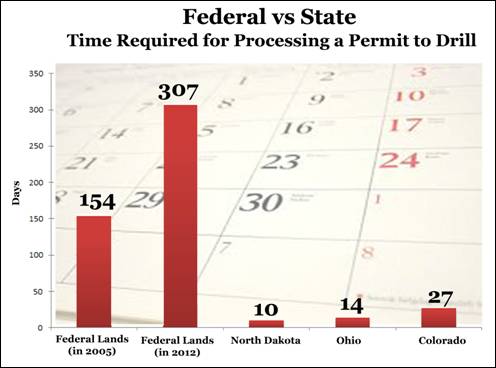Press Release
Witnesses Hail State Energy Policies, Discuss how Federal Red Tape Blocks Much-Needed Energy Production
WASHINGTON, D.C.,
April 17, 2013
|
Committee Press Office
(202-225-2761)
Today, the House Natural Resources Committee held an oversight hearing on "State Lands vs. Federal Lands Oil and Gas Production: What State Regulators are doing right.” This hearing examined the disparity between oil and natural gas production on state and private lands versus production on federal lands.
President Obama has touted that U.S. oil and natural gas production is at its highest levels in years. But he’s only telling half the story. As the Congressional Research Service has noted multiple times, the recent increase in U.S. oil and natural gas production can all be attributed to state and private lands – not federal. “The Obama Administration’s federal energy policies are costing American jobs, impeding economic growth and recovery, and robbing the U.S. Treasury of much needed revenue to help us balance our budget,” said Natural Resources Committee Chairman Doc Hastings (WA-04). “We’ve seen how energy production on state lands can create new jobs. We’ve also seen how energy production on state lands can help ease the pain of high gasoline prices. So why is the Obama Administration refusing to take the same steps as the states to develop these resources?” One of the biggest differences between states and the federal government is in the approval times of applications for permits to drill (APD). On average it takes the Bureau of Land Management (BLM) 307 days to approve a federal APD – nearly double the 154 days it took for the same approval in 2005. This is in sharp contrast to the average time it takes for states to approve an APD, which is on average 12-15 days. (See graphic below)  Witnesses at today’s hearing were clear that states are much more effective at overseeing new energy production and that federal red tape is impeding energy development on federal lands within their states. Utah’s Lieutenant Governor Gregory S. Bell noted that “State and federal APD permits require similar regulatory and engineering reviews, so it is hard to understand why a federal permit should take four times as long to be issued. Utah has shown it is willing to proactively address looming issues, and that its agencies and leaders are competent to craft and execute state-specific policies and regulations to ensure continued environmental health. The status quo of federal overreach is simply unacceptable.” Jerry E. Patterson, Texas Land Commissioner in the Texas General Land Office, confirmed to the Committee that federal regulations are hindering new energy production. “The States lead the way in leasing, permitting, drilling and most important, the production of oil and gas. This administration should look to the states and follow their lead if we are to become energy independent. Sadly, federal policies hamper the development of vitally needed energy.” Richard Simmers, Chief of the Division of Oil and Gas Resources Management for the Ohio Department of Natural Resources, testified that the best way to regulate oil and natural gas is at the state level. “Ohio's oil and gas regulatory program is among the most comprehensive in the country. Ohio's regulations are among the most comprehensive in the country. Ohio continuously strives to evaluate and improve our regulations in response to new information, technologies and developments in the oil and gas industry. I unequivocally believe the regulation of an industry like oil and gas exploration should be administered at the most effective, efficient and economical level, which based on our regulations and highly trained staff, would be at the state level.” ###
|
Newsletter Sign Up
Sign up to receive news, updates and insights directly to your inbox.

